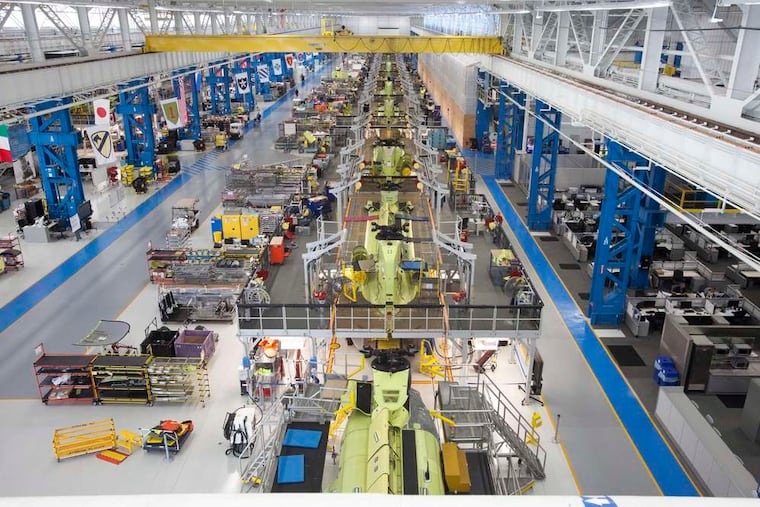Congress saves Boeing’s military helicopters, which will help sustain Ridley Park plant
A hoped-for increase in Chinook upgrades and unexpected Osprey orders improves the long-term hiring forecast in Ridley Park.

Workers at Boeing Corp.’s Ridley Park helicopter plant put down their tools Monday to join managers and engineers at a ceremony thanking Congress for adding funding in the new federal budget for the CH-47 Chinook helicopters and V-22 Ospreys made at the complex, the Philadelphia area’s largest industrial employer.
The new money should end what U.S. Rep. Mary Gay Scanlon (D., Pa.) called “multiple rounds of layoffs” amid years of uncertainty over the future of U.S. military demand for new or rebuilt Chinooks and Ospreys.
But first, there will be more layoffs.
“These are trying times,” said Mike Madigan, shop chair for UAW Local 1069 and a 34-year Boeing veteran.
The union expects the number of workers on the plant’s assembly lines, currently 930, “will go below 800″ later this year, Madigan said, before recovering to around 1,100 around the end of 2026 on increased funding to expand the helicopter’s range and carrying capacity.
The Boeing complex employs around 3,500 people altogether, down from as many as 5,000 in the recent past. Besides the assembly lines, Boeing engineers in Ridley Park work on other products and hope to attract additional work, said Kathleen “KJ” Jolivette, who heads Boeing’s helicopter program.
Boeing officials said the Chinook upgrade program is expected to operate this year and next at what the company calls the “minimum sustainable rate” of around 18 a year. That will increase to around 24 a year by 2027, requiring additional workers, said company and union officials.
“’Minimum sustainable rate’ means they want to slow you down,” said U.S. Rep. Donald Norcross (D., N.J.).
The federal budget also contains funding for around five additional Ospreys, the tilt-rotor aircraft that takes off like a helicopter but flies like a plane. Boeing had been preparing for a possible stoppage of the 250-worker line that produces Ospreys at a second building at Ridley Park once earlier orders were complete, according to people who work at the plant.
The new Osprey funding was “an unexpected bonus,” Scanlon said in an interview outside the plant. She credited U.S. Rep. Kay Granger (R., Texas), chair of the House Appropriations Committee, whose state is home to the Bell helicopter factory that does final assembly work on the Ospreys, for pushing to make more Ospreys.
Osprey “is a big-money project. They were smart enough to put parts and pieces in [many] congressional districts,” according to retired Brigadier Gen. Don Harvel, author of Rotors in the Sand, a book critical of military investigators blaming pilot error for Osprey crashes.
“This takes constant advocacy and work,” said U.S. Sen. Bob Casey (D., Pa.). “If this had stayed on the chopping block, we’d lose more than jobs,” with contractors in Pennsylvania and elsewhere left to seek other work or lay off staff, which Boeing officials say would make it hard to restart the programs later.
Analysts speculate that Boeing could see a substantial reorganization of its commercial aircraft business after last month’s announcement that the unit’s chief, Stan Deal, had been ousted following complaints about management of the company’s 737 MAX airliner program, and that company CEO Dave Calhoun will leave at year’s end.
Boeing helicopter managers and their supporters in government said they saw no signs the change will alter the company’s military business.
“Boeing makes things that last,” said Norcross, noting that with recent and planned updates, Chinooks are expected to remain in service into the 2060s. The first Chinooks flew in 1961. They were used extensively in Vietnam and as heavy-lifting helicopters in Iraq and Afghanistan, and have been sold also to U.S. allies in Europe and Asia.
Besides by the U.S. Marine Corps, Ospreys are also in use in Japan.